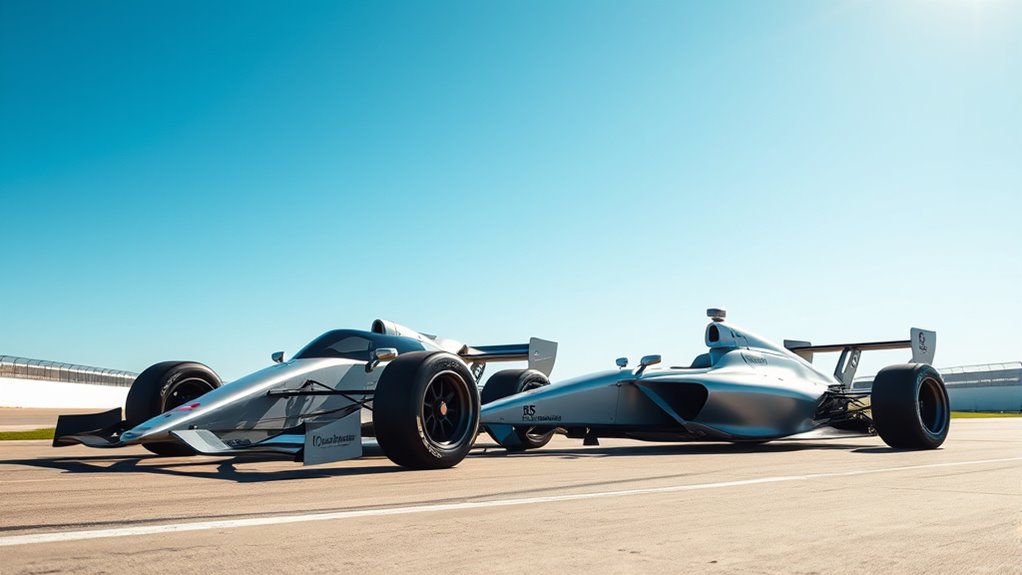If you’re tuning for straight-line speed, a shorter wheelbase can boost agility and acceleration by reducing rotational inertia, allowing quicker throttle response and sharper handling. Conversely, a longer wheelbase provides greater stability, better weight distribution, and enhanced top speed control. Choosing between them depends on your specific goals, track conditions, and vehicle design. To discover how different configurations can optimize your performance, explore further for detailed insights.
Key Takeaways
- Longer wheelbases enhance straight-line stability and reduce wobbling at high speeds.
- Extended wheelbase improves weight distribution, increasing tire contact and grip for better acceleration.
- Short wheelbases offer quicker responsiveness, but may be less stable during high-velocity runs.
- Longer wheelbases reduce airflow disruptions and drag, improving aerodynamic efficiency and top speed.
- The optimal wheelbase length for straight-line speed depends on balancing stability and acceleration needs.
Understanding Wheelbase and Its Role in Vehicle Dynamics

Understanding wheelbase is essential because it directly influences how your vehicle handles and responds on the road. Your wheelbase, the distance between the front and rear axles, affects stability, maneuverability, and ride comfort. A longer wheelbase provides a smoother ride, improves high-speed stability, and reduces the impact of road imperfections. Conversely, a shorter wheelbase makes your vehicle more agile, easier to turn, and better suited for tight corners. It also impacts weight distribution, which can affect traction and braking. Knowing how wheelbase influences these dynamics helps you choose or tune your vehicle for specific driving conditions or performance goals. Whether you’re aiming for better straight-line speed or improved cornering, understanding wheelbase is a critical first step in optimizing your vehicle’s handling characteristics. Additionally, the wheelbase can influence the overall vehicle dynamics, including how it responds during acceleration and deceleration.
The Advantages of Short Wheelbases in Straight-Line Acceleration

A short wheelbase offers distinct advantages when it comes to straight-line acceleration, primarily because it reduces the overall rotational inertia of the vehicle. This lower inertia allows you to transfer power more efficiently to the road, resulting in quicker throttle response and faster acceleration. With a shorter wheelbase, your car can change direction more readily, aiding rapid weight transfer during acceleration. Additionally, it minimizes the effects of torque steer, especially in front-wheel-drive setups. The compact length also means less mass overhang, improving weight distribution during acceleration.
- Faster response to throttle input
- Reduced rotational inertia for quicker power transfer
- Improved weight transfer dynamics
- Less torque steer in FWD vehicles
- Enhanced agility during rapid acceleration
How Long Wheelbases Enhance Stability at Top Speeds

Longer wheelbases provide better traction and grip at high speeds, helping your vehicle stay planted. They also reduce front-end wobble, making your ride smoother and more controlled. As a result, your car gains enhanced stability when cruising at top speeds. Additionally, automation’s role in business intelligence can optimize vehicle performance data, enabling more precise tuning adjustments for your specific driving conditions.
Improved Traction and Grip
When a vehicle has a longer wheelbase, it naturally benefits from increased stability at high speeds, helping you maintain better control on the road. This stability translates into improved traction and grip, especially during straight-line acceleration. A longer wheelbase distributes weight more evenly, reducing weight transfer and keeping tires firmly planted. This results in better contact between the tires and the road surface, enhancing grip. Additionally, the increased stability minimizes side-to-side movement, allowing you to accelerate more confidently. You’ll notice the benefits in:
- Reduced tire slip during acceleration
- Enhanced straight-line stability
- Better weight distribution for traction
- Minimized wheel hop under load
- Improved cornering grip at high speeds
- Suspension upgrades further enhance stability and handling on the road.
All these factors work together to give you a more secure, controlled driving experience on the track or highway.
Reduced Front-End Wobble
Enhanced stability from a longer wheelbase directly reduces front-end wobble at top speeds. When your vehicle has a longer wheelbase, it resists sudden steering inputs and road imperfections that cause front-end oscillation. The added length distributes weight more evenly, creating a more stable platform. This stability minimizes the tendency of the front tires to shake or wobble under high-speed conditions. With less front-end wobble, you experience smoother handling and increased confidence during straight-line runs. The longer wheelbase acts as a stabilizing factor, damping vibrations before they grow into unsettling movements. As a result, your vehicle maintains a more consistent trajectory, reducing steering corrections. Proper suspension setup also plays a crucial role in maximizing stability at high speeds. This stability is especially noticeable at top speeds, where even minor wobbling can compromise control and safety.
Enhanced High-Speed Stability
A longer wheelbase substantially improves your vehicle’s stability at top speeds by providing a more solid and balanced platform. This reduces the tendency to sway or wobble, especially during high-velocity driving. With increased length, your car experiences less lateral movement, making it easier to maintain a straight line. It also helps absorb road imperfections, minimizing sudden shifts that can destabilize your vehicle. Additionally, a longer wheelbase enhances weight distribution, which boosts grip and reduces steering input needed. You’ll notice improved confidence on open highways, especially during fast acceleration or in windy conditions. Decoding slang can help drivers better understand informal terminology often used in automotive communities.
- Better resistance to crosswinds
- Reduced body roll during high-speed turns
- Smoother ride over uneven surfaces
- Improved directional stability
- Less driver fatigue on long trips
Impact of Wheelbase Length on Suspension and Traction

Your wheelbase length directly influences suspension behavior and traction stability. Longer wheelbases tend to smooth out suspension responses, providing better handling over uneven surfaces, while shorter ones can improve cornering agility. Understanding these dynamics helps you optimize your setup for the driving conditions you face.
Suspension Dynamics Variance
The length of a vehicle’s wheelbase considerably influences how its suspension system responds to road irregularities and handling demands. A longer wheelbase tends to smooth out rough surfaces, providing a more stable ride, while a shorter wheelbase reacts more sharply to bumps and turns. This variance affects suspension dynamics, including load transfer and damping behavior. With a longer wheelbase, suspension movement is less responsive but offers better stability, especially at high speeds. Conversely, a shorter wheelbase allows for quicker suspension reactions, enhancing agility. Suspension technology also plays a crucial role in how these dynamics are managed, affecting overall ride quality and vehicle control.
Traction Stability Factors
Wheelbase length directly impacts a vehicle’s traction stability by influencing how suspension responds to road conditions and driving forces. A longer wheelbase distributes weight more evenly, reducing the chances of losing grip during acceleration or cornering. It helps maintain consistent contact between tires and the road, especially under heavy load or rough terrain. Conversely, a shorter wheelbase increases responsiveness but can make the vehicle more prone to instability, especially on uneven surfaces. Suspension setup also plays a pivotal role; a longer wheelbase allows for softer shocks that absorb bumps better, enhancing traction. In contrast, a shorter wheelbase often requires stiffer suspension to prevent excessive body roll, which can compromise traction. Ultimately, wheelbase length affects how well your vehicle maintains grip during straight-line acceleration and sudden maneuvers.
Effect of Short Wheelbases on Handling and Tire Wear

Shorter wheelbases considerably influence a vehicle’s handling dynamics by making it more responsive and agile, especially during quick maneuvers. You’ll notice sharper turn-in, quicker reactions, and increased maneuverability. However, this agility can come with trade-offs. Short wheelbases tend to cause more aggressive tire wear, particularly on the front tires, due to higher lateral forces during cornering. They may also lead to a harsher ride, as less suspension travel absorbs bumps less effectively. Additionally, the increased responsiveness can make the vehicle feel twitchy at high speeds, requiring more precise control.
Shorter wheelbases boost agility but may cause harsher ride and increased front tire wear.
- Increased tire wear on the front tires
- Greater sensitivity to road imperfections
- Higher susceptibility to oversteering
- Reduced straight-line stability at high speeds
- Enhanced agility in tight corners
Long Wheelbases and Their Influence on Drag and Aerodynamics

Long wheelbases improve aerodynamic stability by reducing front-to-rear airflow disruptions, making your vehicle more steady at high speeds. They also minimize pitching movements during acceleration and braking, giving you a smoother ride. Understanding these benefits helps you optimize your car’s performance through wheelbase adjustments. Additionally, considering market research can help you choose the best wheelbase length tailored to your specific racing or driving needs.
Aerodynamic Stability Benefits
Extending the wheelbase can considerably enhance a vehicle’s aerodynamic stability by reducing turbulence and airflow disruptions at high speeds. A longer wheelbase helps smooth airflow over the vehicle’s body, minimizing wake turbulence that can cause instability. This results in better handling and less aerodynamic drag, especially when driving at top speeds. Additionally, the increased length helps maintain a steady airflow across critical aerodynamic surfaces, improving overall stability. You’ll notice that longer wheelbases also reduce the effects of crosswinds and gusts, making high-speed driving safer and more predictable. To optimize these benefits, consider factors like: – Reduced wake turbulence – Smoother airflow over the sides – Improved balance at high speeds – Less wind-induced instability – Better airflow management around rear components and the design of the vehicle’s exterior, which can further influence aerodynamic performance.
Reduced Pitching Movements
Have you noticed how a vehicle’s pitch—its front rising or dipping during acceleration and braking—can affect stability and aerodynamics? Longer wheelbases help reduce these pitching motions because they distribute weight more evenly and increase the distance between axles. This stability minimizes the front-end lift or dip, keeping the car more level during high-speed runs. Reduced pitch means less airflow disturbance around the vehicle, lowering drag and improving aerodynamic efficiency. As a result, your car maintains better contact with the road and experiences less aerodynamic resistance. Long wheelbases effectively dampen the effects of acceleration and braking forces, providing smoother, more stable straight-line performance. This stability not only enhances speed potential but also improves handling, especially at high velocities.
Comparing Weight Distribution and Its Effect on Straight-Line Performance

Weight distribution plays a crucial role in a vehicle’s straight-line performance, influencing how power is delivered and how stability is maintained at high speeds. A balanced setup helps keep the car tracking straight, reducing wheel spin and improving acceleration. When more weight is over the rear wheels, you often see better traction and faster acceleration; too much front bias can cause understeer. Conversely, a front-heavy distribution may improve steering feel but compromise top speed stability. Factors like tire grip, suspension geometry, and power delivery interact with weight placement. Proper weight distribution enhances traction and acceleration, making it a key element in optimizing straight-line speed. Rear bias improves high-speed stability and grip. Front bias can cause understeer at high speeds. Imbalanced setups increase tire wear and handling issues. Fine-tuning distribution optimizes straight-line performance.
Case Studies: Race Cars With Different Wheelbase Configurations

Different wheelbase lengths considerably influence race car performance, as they alter handling characteristics and stability at high speeds. Short wheelbases, like those in Formula 1 cars, enable quick, agile turns, which can be advantageous in tight corners but may compromise high-speed stability. Conversely, long wheelbase race cars, such as certain touring or endurance models, excel in straight-line stability and smooth handling, allowing them to maintain higher speeds more comfortably. For example, the Mercedes-Benz SLR McLaren featured a longer wheelbase that contributed to its stability during high-speed runs, while rally cars like the Subaru Impreza had shorter wheelbases, providing agility in technical sections. Studying these case studies helps you understand how different configurations suit specific racing demands and track conditions.
Tuning Strategies for Optimizing Straight-Line Speed Based on Wheelbase

Optimizing straight-line speed requires tailoring your tuning strategies to your car’s wheelbase length. For short wheelbases, focus on reducing aerodynamic drag and increasing downforce to improve stability at high speeds. With long wheelbases, prioritize suspension stiffness and tire grip to handle the added moment of inertia. Adjust your gear ratios to match your expected power delivery and reduce shifting losses. Fine-tune your suspension settings to optimize weight transfer during acceleration. Additionally, consider these strategies:
- Short wheelbase: Enhance aerodynamics and reduce weight transfer
- Long wheelbase: Increase suspension stiffness for stability
- Gear ratios: Match to powerband for maximum acceleration
- Tire pressure: Optimize for grip and wear
- Downforce: Balance for stability without excessive drag
- Regularly inspect your tires for damage or deformities to maintain optimal performance Bicycle Tire Longevity in Storage.
Practical Considerations When Choosing Between Short and Long Wheelbases

Choosing between a short or long wheelbase depends on your racing goals and the specific conditions you’ll face. Short wheelbases typically offer quicker steering response, making them ideal for tight corners or courses requiring agility. However, they can be less stable at high speeds and may lead to more unpredictable handling in straight-line runs. Long wheelbases provide greater stability and smoother acceleration, especially on open, high-speed tracks. But, they may sacrifice some agility, making tight turns more challenging. Consider your vehicle’s design, weight distribution, and the type of racing you do. If your focus is on straight-line speed with minimal cornering, a longer wheelbase might be preferable. Conversely, if maneuverability and quick directional changes are priorities, a shorter wheelbase could give you an advantage.
Frequently Asked Questions
How Does Wheelbase Affect Overall Vehicle Handling Beyond Straight-Line Speed?
You might wonder how wheelbase influences vehicle handling beyond straight-line speed. A longer wheelbase offers more stability, making your ride smoother and easier to control at high speeds. Conversely, a shorter wheelbase provides better agility, allowing quicker turns and sharper maneuvers. Depending on your driving style, choosing the right wheelbase helps you balance stability and responsiveness, improving overall handling in various driving situations.
Can Changing Wheelbase Impact Fuel Efficiency During High-Speed Runs?
Changing your wheelbase can impact fuel efficiency during high-speed runs. A longer wheelbase tends to improve aerodynamics, reducing drag and helping your vehicle cut through the air more smoothly, which can boost efficiency. Conversely, a shorter wheelbase may increase turbulence and drag, leading to higher fuel consumption. By adjusting your wheelbase, you can optimize your vehicle’s performance, balancing speed and fuel economy to suit your driving needs.
What Are the Cost Implications of Modifying Wheelbase Length?
Think of your car as a ship steering a vast ocean—the cost of changing its wheelbase is like adjusting the ship’s sails. Shortening or lengthening it can mean expensive upgrades to chassis, suspension, and alignment. You might face higher costs for parts, labor, and potential future repairs. While the initial investment can be hefty, it ensures your vehicle performs exactly as you want, sailing smoothly through your racing adventures.
Are There Legal or Regulatory Limits on Wheelbase Modifications?
You need to know that legal and regulatory limits on wheelbase modifications vary by location. Many jurisdictions have specific rules about vehicle dimensions for safety and compliance reasons. You should check local laws before making any modifications, as exceeding these limits can lead to fines, penalties, or failed inspections. Always guarantee your modifications stay within legal boundaries to avoid issues on the road and maintain your vehicle’s legality.
How Does Wheelbase Influence Tire Selection for Optimal Straight-Line Performance?
You’re really chasing the big prize, so understanding how wheelbase influences tire choice is key. A longer wheelbase provides stability and smoother tracking, so you’ll want tires with lower rolling resistance and better grip. Conversely, a shorter wheelbase demands tires that offer agility and quick response. Think of it as the foundation of your setup—get it right, and you’ll be cutting through the air like a hot knife through butter.
Conclusion
Choosing between a short or long wheelbase is like selecting the right arrow for your bow—each offers unique advantages for straight-line speed. Short wheelbases launch you forward with agility, while long ones steady your course like a seasoned sailor. Understand your racing goals, and tune your setup accordingly. With the right balance, you’ll harness your vehicle’s full potential, transforming raw power into a relentless streak across the finish line.









